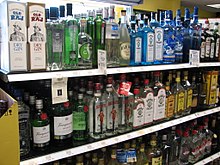
Back جن (مشروب كحولي) Arabic جن (مشروب كحول) ARZ Xinebra (bébora) AST Джын Byelorussian Джин Bulgarian Ginebra (beguda) Catalan Gin Czech Джин CV Jin Welsh Gin Danish
 A selection of bottled gins for sale in Georgia, United States, 2010 | |
| Type | Distilled alcoholic drink |
|---|---|
| Introduced | 13th century |
| Alcohol by volume | 35–60% |
| Proof (US) | 70–140° |
| Colour | Clear |
| Ingredients | Barley or other grain, juniper berries |
| Related products | Jenever |
Gin (/dʒɪn/) is a distilled alcoholic drink flavoured with juniper berries and other botanical ingredients.[1][2]
Gin originated as a medicinal liquor made by monks and alchemists across Europe. The modern gin was modified in Flanders and the Netherlands to provide aqua vita from distillates of grapes and grains, becoming an object of commerce in the spirits industry. Gin became popular in England after the introduction of jenever, a Dutch and Belgian liquor. Although this development had been taking place since the early 17th century, gin became widespread after the 1688 Glorious Revolution led by William of Orange and subsequent import restrictions on French brandy. Gin emerged as the national alcoholic drink of England during the so-called Gin Craze of 1695–1735.
Gin is produced from a wide range of herbal ingredients in a number of distinct styles and brands. After juniper, gin tends to be flavoured with herbs, spices, floral or fruit flavours, or often a combination. It is commonly mixed with tonic water in a gin and tonic. Gin is also used as a base spirit to produce flavoured, gin-based liqueurs, for example sloe gin, traditionally produced by the addition of fruit, flavourings and sugar.